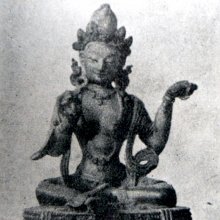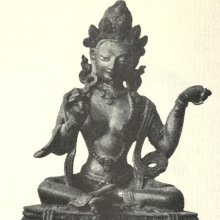Dharmamegha, Dharmameghā, Dharma-megha: 8 definitions
Introduction:
Dharmamegha means something in Buddhism, Pali, Hinduism, Sanskrit. If you want to know the exact meaning, history, etymology or English translation of this term then check out the descriptions on this page. Add your comment or reference to a book if you want to contribute to this summary article.
Images (photo gallery)
In Buddhism
Mahayana (major branch of Buddhism)
Source: Wisdom Library: Maha Prajnaparamita SastraDharmamegha (धर्ममेघ) or Dharmameghabhūmi refers to the “cloud of dharma bhūmi” and represents one of the ten Bodhisattva grounds (bodhisattabhūmi), according to the Daśabhūmikasūtra, or Daśabhūmīśvara, as mentioned in the 2nd century Mahāprajñāpāramitāśāstra chapter 52.—Dharmamegha-bhūmi is also known as “chos kyi sprin, fa yun”. The Bodhisattva on the tenth ground (dharmameghā-bhūmi) should simply be called Tathāgata.—Why should the Bodhisattva on the tenth ground be called simply Tathāgata? When he completely fulfills the six perfections, when he completely fulfills the four foundations of mindfulness up to and including the eighteen special attributes of the Buddhas, when he completely fulfills the knowledge of all the aspects and when he destroys all the passions and their traces, the Bodhisattva-mahāsattva in the tenth ground should be called simply Tathāgata.
Now, O Subhūti, the Bodhisattva-mahāsattva on the tenth ground who, by his skillful means, is practicing the six perfections as well as the four foundations of mindfulness up to including the eighteen special attributes of the Buddha, this Bodhisattva, I say, exceeds:
- the ground of the dry view;
- the ground of the spiritual lineage;
- the ground of the eighth saint;
- the ground of seeing;
- the ground of the diminution of the passions;
- the ground of the saint freed from desire;
- the ground of the saint who has done what had to be done;
- the grounds of the Pratyekabuddha;
- the grounds of the Bodhisattva.
Having exceeded these nine levels, the Bodhisattva is established in the ground of the Buddhas. This is the tenth ground of the Bodhisattva. Therefore, O Subhūti, the Bodhisattva-mahāsattva has “set off well for the Great Vehicle”.

Mahayana (महायान, mahāyāna) is a major branch of Buddhism focusing on the path of a Bodhisattva (spiritual aspirants/ enlightened beings). Extant literature is vast and primarely composed in the Sanskrit language. There are many sūtras of which some of the earliest are the various Prajñāpāramitā sūtras.
Tibetan Buddhism (Vajrayana or tantric Buddhism)
Source: archive.org: The Indian Buddhist IconographyDharmameghā (धर्ममेघा) or Dharmameghābhūmi refers to one of twelve Bhūmi Goddesses, as commonly depicted in Buddhist Iconography, and mentioned in the 11th-century Niṣpannayogāvalī of Mahāpaṇḍita Abhayākara.—Her Colour is blue; her Symbol is a manuscript; she has two arms.
Dharmameghā is described in the Niṣpannayogāvalī (dharmadhātuvāgīśvara-maṇḍala) as follows:—
“Dharmameghā holds in her left hand the prajñāpāramitā manuscript which is composed of the clouds of Dharma”.
[These twelve bhūmis [viz., Dharmameghā] are two-armed and hold in the right hand the vajra and in the left their own weapons or signs.]

Tibetan Buddhism includes schools such as Nyingma, Kadampa, Kagyu and Gelug. Their primary canon of literature is divided in two broad categories: The Kangyur, which consists of Buddha’s words, and the Tengyur, which includes commentaries from various sources. Esotericism and tantra techniques (vajrayāna) are collected indepently.
General definition (in Buddhism)
Source: Wisdom Library: Dharma-samgrahaDharmameghā (धर्ममेघा) or Dharmameghābhūmi refers to the “cloud of dharma” and represents the last of the “ten stages of the Bodhisattva” (bhūmi) as defined in the Dharma-saṃgraha (section 64). The Dharma-samgraha (Dharmasangraha) is an extensive glossary of Buddhist technical terms in Sanskrit (e.g., dharma-meghā). The work is attributed to Nagarjuna who lived around the 2nd century A.D. Arciṣmatī is also included in the “thirteen stages of the Bodhisattva” (trayodaśa-bhūmi).
Languages of India and abroad
Sanskrit dictionary
Source: DDSA: The practical Sanskrit-English dictionaryDharmamegha (धर्ममेघ).—a particular Samādhi.
Derivable forms: dharmameghaḥ (धर्ममेघः).
Dharmamegha is a Sanskrit compound consisting of the terms dharma and megha (मेघ).
Source: Cologne Digital Sanskrit Dictionaries: Edgerton Buddhist Hybrid Sanskrit DictionaryDharmameghā (धर्ममेघा).—name of the tenth Bodhisattva-bhūmi (in the usual list; compare abhiṣeka, °ka-vatī): Mahāvyutpatti 895; Dharmasaṃgraha 64; Bodhisattvabhūmi 354.26; Laṅkāvatāra-sūtra 15.5; Daśabhūmikasūtra 5.10, etc.
Source: Cologne Digital Sanskrit Dictionaries: Monier-Williams Sanskrit-English Dictionary1) Dharmamegha (धर्ममेघ):—[=dharma-megha] [from dharma > dhara] m. a [particular] Samādhi, [Yoga-sūtra] (-dhyāna; n. a [particular] state of mind connected with it, [ib. [Scholiast or Commentator]])
2) Dharmameghā (धर्ममेघा):—[=dharma-meghā] [from dharma-megha > dharma > dhara] f. Name of one of the 10 Bhūmis, [Buddhist literature]
[Sanskrit to German]
Sanskrit, also spelled संस्कृतम् (saṃskṛtam), is an ancient language of India commonly seen as the grandmother of the Indo-European language family (even English!). Closely allied with Prakrit and Pali, Sanskrit is more exhaustive in both grammar and terms and has the most extensive collection of literature in the world, greatly surpassing its sister-languages Greek and Latin.
See also (Relevant definitions)
Partial matches: Dharma, Megha, Tarma.
Starts with: Dharmameghabhumi, Dharmameghadhvajapradipa, Dharmameghadhyana, Dharmameghanagarabhapradiparaja, Dharmameghanirghosharaja, Dharmameghavighushtakirtiraja.
Full-text (+15): Dharmameghadhyana, Dharmameghabhumi, Sampraticchana, Sampraticchaka, Abhisambhinna, Sampratyeshana, Sampratyeshaka, Bhumi, Dvadashabhumi, Purushanyata, Anyata, Rajolesha, Apeta, Pradyota, Svarupapratishtha, Mohavarana, Pradyotamana, Malapeta, Moha, Dhyanopaga.
Relevant text
Search found 18 books and stories containing Dharmamegha, Dharmameghā, Dharma-megha, Dharma-meghā; (plurals include: Dharmameghas, Dharmameghās, meghas, meghās). You can also click to the full overview containing English textual excerpts. Below are direct links for the most relevant articles:
Yoga-sutras (with Vyasa and Vachaspati Mishra) (by Rama Prasada)
Sūtra 4.29 < [Book 4 - Absolute Independence (Kaivalya)]
Sūtra 2.24 < [Book 2 - Practice (Sādhana)]
The Indian Buddhist Iconography (by Benoytosh Bhattachacharyya)
Yoga-sutras (Ancient and Modern Interpretations) (by Makarand Gopal Newalkar)
Sūtra 4.29 [ Dharmamegha-samādhi] < [Book IV - Kaivalya-pāda]
Sūtra 4.31 < [Book IV - Kaivalya-pāda]
Sūtra 4.28 < [Book IV - Kaivalya-pāda]
Maha Prajnaparamita Sastra (by Gelongma Karma Migme Chödrön)
Note (3). The ten grounds shared by adepts of the three vehicles < [Chapter XX - (2nd series): Setting out on the Mahāyāna]
Bhūmi 10: the ground of the cloud of the Dharma (dharmameghā) < [Chapter XX - (2nd series): Setting out on the Mahāyāna]
Jainism and Patanjali Yoga (Comparative Study) (by Deepak bagadia)
Annexure 3: States of spiritual journey according to Yoga
Part 3 - Concept and Nature of liberation (Moksha / Kaivalya) < [Chapter 4 - A Comparative Study]
Part 4 - Doctrine of karma < [Chapter 4 - A Comparative Study]
Yoga-sutras (with Bhoja’s Rajamartanda) (by Rajendralala Mitra)
Sūtra 4.28 < [Fourth Chapter (Samadhi Pada)]


